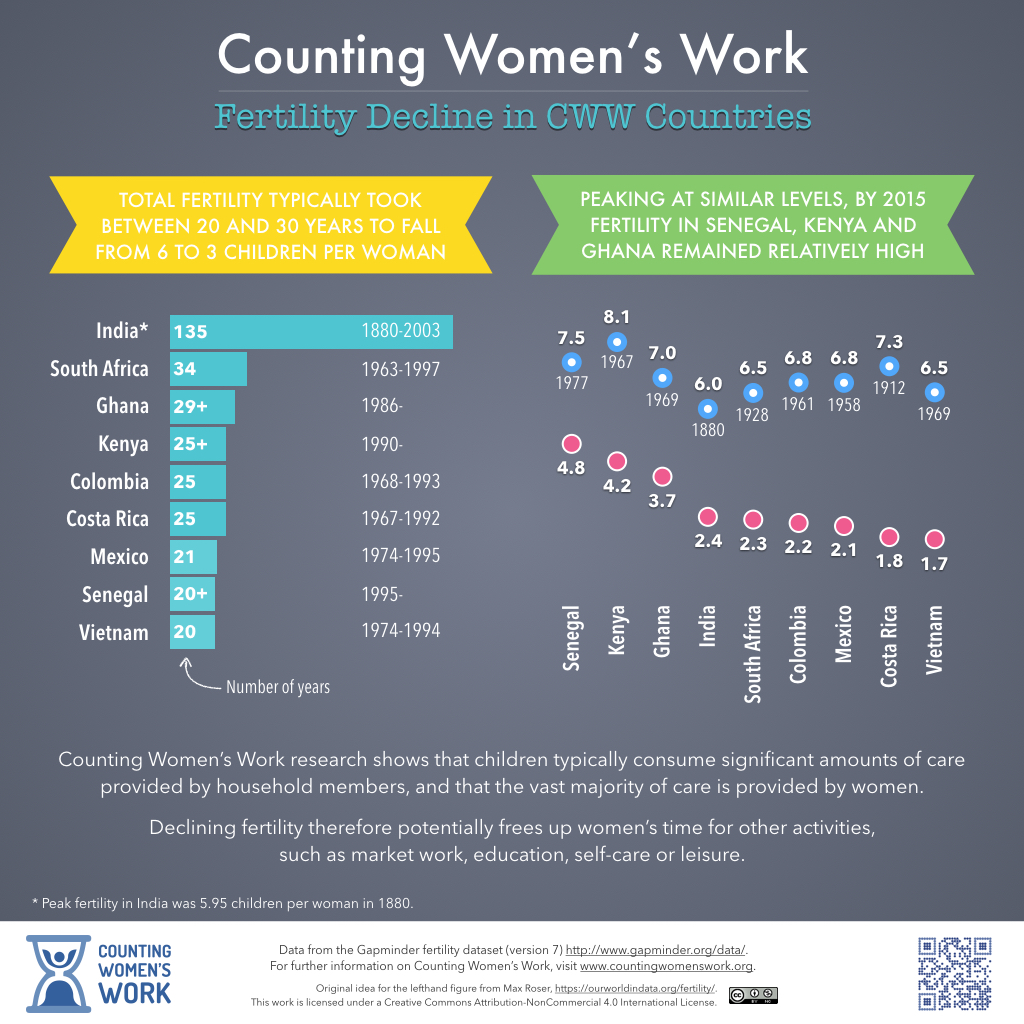Infographic, Ghana
CWW infographics summarize the market-based and unpaid care work economy in a country. This post shows the infographic for Ghana.
Counting Women’s Work estimates of the market and unpaid care work economies can be summarized with a series of statistics. CWW produces infographics to show these results. Infographics are available with a dark or light background. The infographic for Ghana is shown below.
All infographics are licensed under a Creative Commons Attribution-NonCommercial 4.0 International License.
Incorporating household production into the National Transfer Accounts for Slovenia
A group of CWW and NTA researchers has published "Incorporating household production into the National Transfer Accounts for Slovenia" in the journal Post-Communist Economies.
Sambt, J., Donehower, G., and Verbič, M. (2016) “Incorporating household production into the National Transfer Accounts for Slovenia.” Post-Communist Economies, 28(2): 249-267.
ABSTRACT:
The National Transfer Accounts (NTA) have recently been developed to measure economic flows across age groups. In this article, we extend the NTA for Slovenia by including the value of unpaid household production. Based on time-use data, we discover that people in Slovenia spent even more time on household production than on paid work, which emphasises the necessity of including household production in the NTA analysis. We find that there are large net transfers of household production flowing from adults to children, and to a lesser extent also to the elderly. We calculate unpaid production separately for both genders, and discover that females provide much more unpaid production and total productive work than males. In addition, they face a much more intensive ‘rush hour of life’ than males. We expect that similar patterns may be found in other post-communist countries where equalising labour force participation by gender was central to the communist agenda, but where no similar efforts were undertaken to equalise household work burdens.
CWW Country Report, South Africa
The first CWW Country Report features results from South Africa.
CWW country reports provide an overview of the estimates for that country. These include age profiles of market labor income and consumption by sex from National Transfer Accounts. To include unpaid care work, consumption and production from National Time Transfer Accounts are included as well. The first country report published is from South Africa. Please click the link below to view the report.
Retos para materializar el dividendo de género
Costa Rica team leader Pamela Jiménez-Fontana has published the article "Retos para materializar el dividendo de género" in the journal Revista Población y Salud en Mesoamérica.
Jiménez-Fontana, P., 2016. "Retos para materializar el dividendo de género". Revista Población y Salud en Mesoamérica, 13(2).
ABSTRACT:
The gender dividend is a potential opportunity for economic growth due to an increase in women’s participation in the labor market; however, non-remunerated work can be a barrier to increase women’s labor force participation. In order to analyze the relationship between non-remunerated production and the potential gender dividend, this article analyzes time use age profiles, and the non-remunerated production and consumption in Costa Rica. Furthermore, the study estimates a potential unmet demand of childcare. The paper uses the methods developed by the international network National Transfer Accounts. The main results of the study confirm that women are the responsible for household work, while men on average specialize in the labor market. The results show that there is not more co-responsibility between men and women of younger generations. The materialization of the gender dividend depends heavily on public policies that seek to reduce women’s household workload and increase quality jobs opportunities.
Infographic, Fertility Decline in CWW Countries
Counting Women’s Work countries are all experiencing falling fertility, but the pace of decline varies widely across countries. The infographic comparing fertility levels and change is shown below.
Counting Women’s Work countries are all experiencing falling fertility, but the pace of decline varies widely across countries. The infographic comparing fertility levels and change is shown below.
All infographics are licensed under a Creative Commons Attribution-NonCommercial 4.0 International License.
Infographic, Senegal
CWW infographics summarize the market-based and unpaid care work economy in a country. This post shows the infographic for Senegal.
Counting Women’s Work estimates of the market and unpaid care work economies can be summarized with a series of statistics. CWW produces infographics to show these results. Infographics are available with a dark or light background. The infographic for Senegal is shown below.
All infographics are licensed under a Creative Commons Attribution-NonCommercial 4.0 International License.
Categories
Tags
- Africa 3
- Asia 3
- Audio 2
- Brazil 1
- Burkina Faso 2
- Colombia 10
- Costa Rica 10
- Covid19 2
- Cross-country 19
- El Salvador 1
- Europe 5
- Example Code 1
- Fertility 2
- Gender Dividends 3
- Ghana 4
- Hispanic ethnicity 1
- Human Capital 1
- Hungary 1
- India 3
- Kenya 2
- Latin America 7
- Mauritius 2
- Methodology 6
- Mexico 4
- Policy-related 10
- Senegal 5
- Slides 10
- Slovenia 1
- South Africa 9
- South Korea 2
- Spain 2
- Spanish language 4
- Turkey 1
- United States 3
- Uruguay 2
- Video 7
- Vietnam 4
- Web Conference 4














